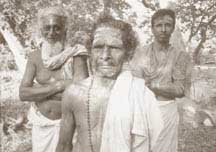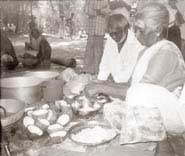
|
|||||||||||
|
| |||||||||||
 Pada Yatra for Peaceby Umangi de Mel
'Pada Yatra' is one of the oldest traditions of mankind and a ritual that did not lose its appeal even during the years of war. Originally, it was a journey from Kailash, the nothern most point of Hindu worship in the Himalayas to Kataragama in Sri Lanka, which is the southern most point. However, it later became more popular as the foot pilgrimage from Jaffna to Kataragama and is today an annual event in the calendar of activities. This year too, the pilgrims will leave Jaffna during Wesak. "We do not force anyone to join in. It is a matter of becoming a family for 45 days. We have no divisions, but a joining of all faiths. Buddhists, Muslims and Tamils will join us in large numbers from along the east coast," says Manik Sandrasagra, organiser of the forthcoming 'Pada Yatra'. He describes it as an event that will help to re-position our image as a multi religious country. The main objective of the event is to show that Sri Lanka needs no brokers to bring peace he says adding "We do not involve politics in our Yatra. All we need is to articulate the real Śrī Lanka on the peace initiative rather than articulating the urban interest." According to Sandrasagra, the tradition of following the sun in a foot pilgrimage is as old as mankind. Five hundred years ago, animals came down from the heights of the Indian plains to the lowlands of Sri Lanka, after the landmass was merged. 'Elephant Pass', the now famous battlefield is where the elephants passed. Man traced these trails and soon they settled down in Sri Lanka. It is believed that Lord Kataragama, otherwise known as 'Skanda', or rather, 'Shivagurunadhan' (so called as he is known to be the master of his father, Lord Shiva,) was the first pilgrim to have started out from 'Kailash' and journeyed in search of 'Valli', his mythical Veddah Princess in Gajaragama (Kataragama) at the southern most point. Kataragama and Kailash sit on the same vertical access, thus Kailash was considered as the peak while Kataragama was the base of the imaginary spinal cord. Thambapanni has been a land of pilgrimage from ancient times. It was the land of the blessed where trees and animals were sacred. Ganesh, the divine sibling of Skanda is said to have led the way in the form of an elephant, with his devotees advancing with him. " 'Pada Yatra'is a procession of the meek. A journey of the ordinary to see the cherished Gods, which is a tradition that invites people to be a part of the simple nature, says Sandrasagra. For a culture comprising a large number of village shrines and hundreds of Gods, Lord Skanda was the 'Mahasenadhipathi' of pious souls. He was a Lord who had two wives, and crept every night from his mansion to visit his jungle sweetheart. This was an open defiance of the Vedhik rules and the North Indian morals, but at the same time, it depicted the simple, unassuming lifestyle that was noncombatant and impartial. Wednesdays and Saturdays the God was given venison as pooja. Lord Skanda was also called 'Arumugam' (six faced) depicting his role as king, hunter, lover, beggar, sanyasi (sadhu) and swami. This was a wonderful concept that revealed that life was not only lived virtuously. The pilgrims who wade the rivers a long way pay homage to the various facets of Lord Skanda. The Esala festival, which is called the "Wedding of the Goddess" is celebrated during Sinhala New Year, Esala and the Il Maha Mangallaya in November. Five hundred and five 'Rajakariya People' who served the King are summoned to carry out the function that is an enactment of the love that was between Lord Skanda and Valli Amma. "It is a re-enactment of the male, female principles," Sandrasagra says, adding: "The starting grounds for the festival is a Mosque, and for the Muslim pilgrim, Lord Skanda is the Green Sufi, the teacher of Abraham," Kataragama is their Al Khidr-Khizdr country. Thus the 'Pada Yatra' becomes a multi-religious ritual in which all the religions come together as one. Pilgrims travel in 'kuttams' which could be families or friends. "The event is not an organized peace-march but it is something that starts on a given day and people join in at different places," Sandrasagra explains adding that the paths to divinity is opened with devotees faithfully leaving their foot prints. According to Sandrasagra, a pioneer of the event, the foot pilgrimage came to an end in 1983 due to the ethnic war, but was restored in 1988 from Jaffna. "After the Jaffna sections were stopped in 1989, we have been coming from Trincomalee," he says. This year the procession starts from Jaffna with the pilgrims gathering at Mullaitivu for the festival at the Kanaki Amman Kovil, which is during Wesak. "In 1988 there were just two of us from Jaffna, but 60 by the time we reached Kataragama. In 1975, it was about 2000, but last year the number was 10,000," he recalls. The difficulty arises when the number of pilgrims swell. We need elders to be the leaders in the pilgrimage to prevent the youth from polluting these areas with "plastic, garbage and forest fires. We want to teach them to leave the country as they found it," says Sandrasagra. "Our resting place will be shrines and we will be crossing rivers like Verugal, Kumbuk and Menik." At the dawn of Wesak the pilgrims of all races and religions will descend from Jaffna pausing at places that will not offer them luxury but basic shelter. The purpose of the pilgrimage is to see the God whom every Muslim, Tamil and Sinhalese accepts with great devotion. The bottom line is to bring in peace to a country that has a lovely blend of humans through a simple and modest custom. This article first appeared in The Sunday Observer (Colombo) of Sunday, 14 April 2002 . Enquiries by e-mail: info@padayatra.org Pada Yatra pilgrims help to build a National Vision
|
|
|
| Living Heritage Trust ©2023 All Rights Reserved |


